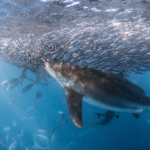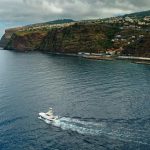Article courtesy: Fisheries and Oceans Scientist Dr. John Smith | www.pac.dfo-mpo.gc.ca | Please Click Here for Original Article.
Above: Figure 1. Map showing the location of the site of the Fukushima Dai-ichi Nuclear Power Plant accident in Japan. Stations are indicated at which seawater samples were collected in 2011-2014 on Line P and in 2012 in the Beaufort Sea. Box B represents the model domain for which Fukushima-derived Cs-137 time-series concentrations were estimated by Behrens et al. (6). Station R is the cross shelf regime for which the Rossi et al. (7,8) model results apply. Inset shows sampling station locations along Line P. Dashed curves are time-averaged streamlines representing the mean dynamic height field for 2002-2012 indicating the northward geostrophic transport of the Alaska Current across Line P.
A paper published in December 2014 in the Proceedings of the National Academy of Sciences (PNAS) details the arrival and concentration of radioactive isotopes from the Fukushima nuclear reactor in the North Pacific Ocean. This paper, by Fisheries and Oceans scientist Dr. John Smith, documents the first and only systematic study of its kind validating ocean circulation models while tracking the eastward movement of radioactive isotopes.
On March 11, 2011, a massive 9.0 magnitude earthquake triggered a tsunami off the coast of Japan, severely damaging the Fukushima Dai-ichi Nuclear Power Plants resulting in the discharge of a radioactive plume into the atmosphere and ocean. The radioactive material that entered the ocean moved eastward towards North America via the Kuroshio and North Pacific current systems.
Fisheries and Oceans Canada (DFO) established an ocean monitoring program using radioactive isotopes Cs-134 and Cs-137 to validate ocean circulation models and trace the arrival of Fukushima radioactivity in the Pacific and Arctic Oceans. Between 2011 and 2014, DFO researchers on board the Canadian Coast Guard Ship John P Tully took measurements of radioactivity along Line P, which extends 1500 km westward from Victoria, B.C. to the interior of the North Pacific. Samples were also collected in the Beaufort Sea in 2012 to check for the presence of Fukushima radiation in the deep Arctic Ocean by DFO scientists on the Canadian Coast Guard Ship Louis S St. Laurent.
In June 2012, about 1.3 years after the accident, a small amount of Fukushima Cs-134 was detected at the western end of Line P. Measurements of this short-lived isotope indicate that the source is from Fukushima and allows researchers to then determine what portion of the longer-lived isotope (Cs-137) comes from Fukushima and what portion was pre-existing. By June 2013, Cs-134 was detected in surface waters all along Line P to the Canadian continental shelf.
Ocean circulation model estimates indicate that future total levels of Cs- 137 off the North American coast will likely peak at 3-5 Bq/m3 by 2015-2016, before declining to levels closer to 1 Bq/m3 by 2021. The increase in Cs-137 levels in the eastern North Pacific from the Fukushima reactor will probably return to background radiation levels that prevailed during the 1980s. Cesium-137 exists in the Pacific Ocean at a background level of approximately 1 becquerel per cubic meter of water. Since the Fukushima incident, radiation levels off the BC coast have increased to about 2 becquerels and its expected to peak in 2015-16 at about 5 becquerels per cubic meter of water. To put that in perspective – Canada’s standard for Cesium-137 in drinking water is 10,000 becquerels per cubic metre meaning that the increase in Cesium-137 in Canadian Pacific waters do not represent a threat to human or animal health.
While these results suggest that Fukushima-generated radiation levels do not represent a threat to Canada, studies such as these allow scientists to better assess potential impacts on human health and the environment now and in the future.






